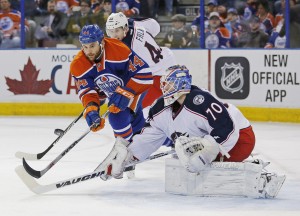Better late than never, I suppose.
Once again, the Columbus Blue Jackets find themselves playing better hockey in the new year after starting the season about as bad as anyone possibly can. While it’s good that the team has finally put it together, it’s frustrating that it takes three months or more to get there.
This has been the way of life for the Blue Jackets the last few seasons.
Slow Octobers and Novembers have put the Blue Jackets in too big a hole to overcome, despite their strong finishes. Last year, injuries killed the team at the start. Then when everyone got healthy, the team started rolling. This season, Sergei Bobrovsky got off to a bad start, causing the team to spiral out of control not even 10 games into the season. 0-8-0 is all it takes to put you out of the race before it even began.
In a long season, teams find both hot and cold streaks, for different reasons. This recent hot streak, feels different from the rest. Last season, the team had no pressure, and just played, to the tune of a 15-1-1 finish. This season proved that it was fool’s gold.
Then came a major in-season trade that shook the Blue Jackets up. Star center Ryan Johansen went to Nashville, and in came talented defenseman Seth Jones. Since Jones’ arrival in Columbus, the team has trended upwards. Their play and their record show this. I get the feeling this is more sustainable than other hot streaks before it.
The prevailing thought was that the Blue Jackets defense would see an immediate boost, while the offense and power play would struggle due to the loss of Johansen. The numbers in the early going since the trade are pleasantly surprising and positive for the Blue Jackets.

The Jones Impact
The Blue Jackets are a respectable 8-5-4 in 17 games since Jones arrived in Columbus. More recently however, the Blue Jackets are on a 6-game point streak (4-0-2), and are 6-1-3 in their last 10 games.
The first place we need to look is the defense. The Blue Jackets now boast a Top 4 who can each play heavy minutes. Jones plays with Ryan Murray, while Jack Johnson plays with normal partner David Savard. This allows the Blue Jackets to field Fedor Tyutin and either Dalton Prout or Cody Goloubef as the third pair. This is a more stabilized group. Their goals against reflects this.
Prior to the trade, the Blue Jackets allowed the most goals in the league. In the 41 games before Jones, the Blue Jackets allowed 3.17 goals/game. In the 17 games since, they’ve allowed 2.88 goals/game, a drop of almost .30. There’s your immediate impact that many expected to see. Here’s the somewhat surprising part.
The Blue Jackets before Jones scored 2.54 goals/game. In the 17 games with Jones, they’ve scored 2.59 goals/game. It has actually gone up, albeit by a very small margin. When you lose a potential 70-point scorer, replacing him is hard.
At least in the early going, the Blue Jackets have maintained the same scoring pace as before. This starts with the current top line of Boone Jenner, Brandon Dubinsky, and Cam Atkinson. They have 19 goals and 35 points since the trade. As they get more games together, we’ll see if they can keep this pace up.

An Unexpected Jolt
When both goalies went down to injury, many thought the Blue Jackets would struggle. Instead, after a slow start, Joonas Korpisalo has flourished in-goal. Nobody saw this coming.
Korpisalo is on a streak in which he has allowed three goals or less in 12 of his last 13 starts. He makes the saves you expect, while making others that are spectacular. His play has given a jolt to the rest of the lineup.
To put Korpisalo’s play into perspective, consider these numbers in his games (thanks to Puckalytics for this data). His current save percentage of .923 ranks better than Ben Bishop, Marc-Andre Fleury, Jonathan Quick, Martin Jones, and Tuukka Rask. Korpisalo’s .923 save percentage puts him 11th in the league (minimum 1000 minutes played).
At 5-on-5, Korpisalo’s save percentage is .940, which is 10th in the league. Now consider this. His shots against per 60 in all situations is the 2nd highest in the league (32.77) and his Corsi against per 60 is also 2nd highest in the league (62.30). He faces a heavy workload, and is performing at a top 10 level. His play has allowed the Blue Jackets to not rush Sergei Bobrovsky back to the lineup.
#CBJ G Sergei Bobrovsky skated away from the group in OhioHealth Ice Haus this morning. No timetable for his return.
— Aaron Portzline (@Aportzline) February 16, 2016
In the end, a hot goalie and a better defense has translated to better play for the Blue Jackets. They’ve gotten better defensively, and kept the same pace offensively. Can Korpisalo keep this kind of pace up? With a solid defense in front of him, and timely scoring, he certainly can do so.
This feels more sustainable in the long run. Never before have the Blue Jackets been this talented defensively. Will this finally mark the end of the slow start? We won’t know until next season. But for now, enjoy a team who is actually in every game, and could win every game. It’s what you wanted from the start, even if it took half the season to get there.